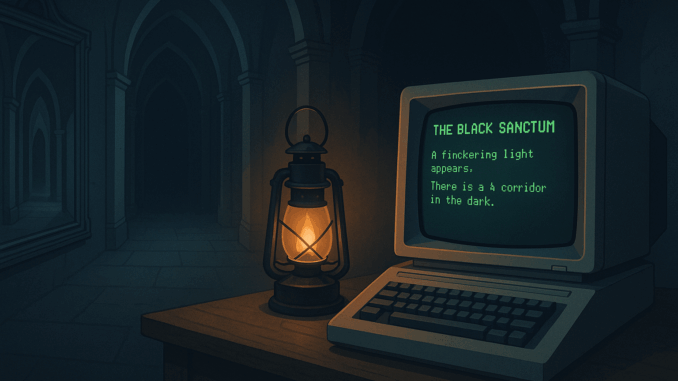
From Cozy Living Room to Haunted Monastery
In the early 1980s, long before high‑resolution visuals or voice‑acted cutscenes, a family’s living room in Preston (as it was for me at age ten) transformed into a shared realm of puzzles and peril the moment The Black Sanctum booted up. What began as individual exploration soon evolved into a cooperative event: mapping the snow‑covered slopes, debating whether “GO MIRROR” was a trap or a gateway, and eagerly waiting for the flicker of those flashing monk-eyes to signal our next collective decision. For families around the UK and US, this wasn’t a solitary pastime-it was an evening ritual.
A Game Across Two Frontiers: US Hardware, UK Imprint
The Black Sanctum has deep roots:
- Text adventure by Ron Krebs, debuting June 1981 on hobbyist FLEX-based systems, then ported to TRS‑80 Color Computer and Dragon 32/64 that August (lcurtisboyle.com).
- Graphical remake by Stephen O’Dea & Bob Withers, released as part of Mark Data Products’ CoCo graphic‑adventure series in 1984 (gamingafter40.blogspot.com).
Mark Data Products-a name blending “Mona and Ron Krebs”-launched six adventures between 1981-1986. The Black Sanctum stood out on both CoCo and Dragon’s 32 KB RAM limit, often loaded from cassette with textured screens that remain hauntingly effective (ifdb.org).
Anatomy of a Chilling Quest
Atmosphere Through Action
Unlike broader text adventures, CoCo’s Black Sanctum made atmosphere active:
- A looping snowstorm hides your cabin, and NPC lines like “It’s getting cold… shut the door!” imbue time with meaning (ifdb.org).
- Parallax scrolling clouds and animated fire sustain tension from the outset (gamingafter40.blogspot.com).
- Flashing eyes of monks aren’t just decorative-they warn of danger, especially without the black robe, and punish curiosity (gamingafter40.blogspot.com).
You feel exposed, outnumbered-every step counts.
Puzzle Design with Consequence
The game unfolds via logical staging:
- Explore the mountain-cabin loop to avoid frustrating blind‑folds.
- Discover the mirror portal and cloak-a transformation point both narratively and tactically (bluerenga.blog, archive.org).
- Collect ritual items-altar parts, hair, needles, water, salt, feather-with clear connections between map and story (gamingafter40.blogspot.com).
- Manage risk: The lantern’s timer and risk of random death demand planning .
Soft‑locks, famously unforgiving, push players to rethink: “Did I miss the shears before she turned to stone?” . It’s not sadism-it’s immersion.
Technical Feats Within Severe Limits
- 32 KB RAM footprint with cassette or floppy loading required clever graphics re‑use and compression (youtube.com, gamingafter40.blogspot.com).
- MC6809 assembly under Micro Works MACRO‑80C squeezed performance into minimalist hardware (ifdb.org).
- Cross‑platform reach extended to PC CGA, even if faltering, furthering legacy beyond hobbyist lime (ifdb.org).
These were feats that teased future expectations of what small machines could do.
A Gateway Rather Than “Just a Text Adventure”
To a ten‑year‑old me, it wasn’t a parser puzzle-it was an eerie monastery, a kidnapped maiden, and an alien corridor behind a mirror. Working as a family, we:
- Drew maps, every twist and loop committed to paper.
- Bounced theories: “Maybe the jug of wine is a key!”
- Felt tension: the game’s soft deadlines (lantern time, statue‑irrevocable curse) made each decision weighty.
These collaborative rituals were a proving ground for patience, logic, and imagination-an experiential gateway far removed from static arcade scores or instant gratification.
Echoes in Digital Culture
Thanks to preservation efforts-IFDB records, CoCo emulator communities, internet archives-Black Sanctum remains playable (even on DOS scripts) and studied (gamingafter40.blogspot.com, bluerenga.blog, ifdb.org). Analyses like Renga in Blue praise both eerie atmosphere and elegant story‑puzzle cohesion (bluerenga.blog).
This is the era that proved narrative could come from typed words and simple visuals, paving the way for console RPGs, point‑and‑clicks, and narrative‑driven indie experiences.
Why It Still Matters
The Black Sanctum reminds us that games, even early ones, weren’t distractions-they were events. Sitting cross‑legged in front of a fuzzy CRT, we:
- Collaborated with family and friends in real time.
- Mapped vast imaginary spaces that existed nowhere else.
- Felt tension, dread, and triumph from typed words and blinking graphics.
A “boring” text adventure? Far from it. It was one of the earliest communal digital experiences-less pixel, more shared narrative. It shaped how I see games today-not just as mechanics, but as collaborative emotion engines.
Play It Today
- Emulate the graphical CoCo or Dragon cassette version via archive.org or runnable CoCo emulators (archive.org).
- Try the original text‑only 1981 version if you crave minimalism (lcurtisboyle.com).
- Variables: PC CGA version exists, but graphical fidelity may vary (ifdb.org).
Final Thoughts
The Black Sanctum isn’t merely a relic-it’s a beacon. It reminds us of the magic in community storytelling, the deep engagement possible with sparse resources, and the enduring power of careful design. To my ten‑year‑old self, and to every family that shared its screen, it was more than code-it was conjuration.
So invite a friend or family member. Light a candle. Start at the cabin door. You’re not just playing a game-you’re stepping into a shared world, guided by text, memory, and imagination.

Leave a Reply